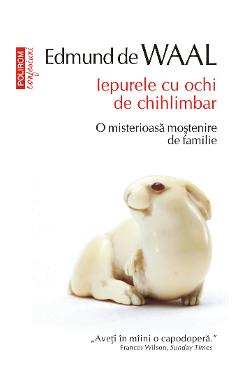The Hare with Amber Eyes: A Hidden Inheritance - Edmund De Waal

Detalii The Hare with Amber Eyes:
libris.ro
111.6 Lei
124 Lei
Biography & Autobiography
Edmund De Waal
The Hare with Amber Eyes: - Disponibil la libris.ro
Pe YEO găsești The Hare with Amber Eyes: de la Edmund De Waal, în categoria Biography & Autobiography.
Indiferent de nevoile tale, The Hare with Amber Eyes: A Hidden Inheritance - Edmund De Waal din categoria Biography & Autobiography îți poate aduce un echilibru perfect între calitate și preț, cu avantaje practice și moderne.
Caracteristici și Avantaje ale produsului The Hare with Amber Eyes:
- Departament: auto-moto-rca
- Ideal pentru iubitorii de mașini și motociclete.
- Conținutul acestui produs te ajută să întreții și să îmbunătățești performanțele vehiculului tău.
Preț: 111.6 Lei
Caracteristicile produsului The Hare with Amber Eyes:
- Brand: Edmund De Waal
- Categoria: Biography & Autobiography
- Magazin: libris.ro
- Ultima actualizare: 28-10-2025 01:22:05
Comandă The Hare with Amber Eyes: Online, Simplu și Rapid
Prin intermediul platformei YEO, poți comanda The Hare with Amber Eyes: de la libris.ro rapid și în siguranță. Bucură-te de o experiență de cumpărături online optimizată și descoperă cele mai bune oferte actualizate constant.
Descriere magazin:
A New York Times Bestseller An Economist Book of the Year Costa Book Award Winner for Biography Galaxy National Book Award Winner (New Writer of the Year Award) Edmund de Waal is a world-famous ceramicist. Having spent thirty years making beautiful pots--which are then sold, collected, and handed on--he has a particular sense of the secret lives of objects. When he inherited a collection of 264 tiny Japanese wood and ivory carvings, called netsuke, he wanted to know who had touched and held them, and how the collection had managed to survive. And so begins this extraordinarily moving memoir and detective story as de Waal discovers both the story of the netsuke and of his family, the Ephrussis, over five generations. A nineteenth-century banking dynasty in Paris and Vienna, the Ephrussis were as rich and respected as the Rothchilds. Yet by the end of the World War II, when the netsuke were hidden from the Nazis in Vienna, this collection of very small carvings was all that remained of their vast empire. A New York Times Bestseller An Economist Book of the Year Costa Book Award Winner for Biography Galaxy National Book Award Winner (New Writer of the Year Award) Edmund de Waal is a world-famous ceramicist. Having spent thirty years making beautiful pots--which are then sold, collected, and handed on--he has a particular sense of the secret lives of objects. When he inherited a collection of 264 tiny Japanese wood and ivory carvings, called netsuke, he wanted to know who had touched and held them, and how the collection had managed to survive. And so begins The Hare with Amber Eyes, this extraordinarily moving memoir and detective story as de Waal discovers both the story of the netsuke and of his family, the Ephrussis, over five generations. A nineteenth-century banking dynasty in Paris and Vienna, the Ephrussis were as rich and respected as the Rothchilds. Yet by the end of the World War II, when the netsuke were hidden from the Nazis in Vienna, this collection of very small carvings was all that remained of their vast empire. A New York Times Bestseller An Economist Book of the Year Costa Book Award Winner for Biography Galaxy National Book Award Winner (New Writer of the Year Award) Edmund de Waal is a world-famous ceramicist. Having spent thirty years making beautiful pots--which are then sold, collected, and handed on--he has a particular sense of the secret lives of objects. When he inherited a collection of 2

Produse asemănătoare

The Hare with Amber Eyes: A Hidden Inheritance - Edmund De Waal
![]() libris.ro
libris.ro
Actualizat in 28/10/2025
111.6 Lei

People with Dementia at the Heart of Research. Co-Producing Research through The Dementia Enquirers Model, Paperback/Philly Hare
![]() elefant.ro
elefant.ro
Actualizat in 28/10/2025
187.99 Lei

The Leaping Hare Nature Almanac. Your Yearlong Mindful Guide to Reconnecting with Nature, Hardback/Leaping Hare Press
![]() elefant.ro
elefant.ro
Actualizat in 28/10/2025
144.99 Lei

The Hare with Amber Eyes (Illustrated Edition): A Hidden Inheritance - Edmund De Waal
![]() libris.ro
libris.ro
Actualizat in 28/10/2025
279 Lei

At the Edge: What Is Mine to Do? And Who Can I Do It With?, Paperback/Kimberley Hare
![]() elefant.ro
elefant.ro
Actualizat in 27/10/2025
79.99 Lei
Produse marca Edmund De Waal

The Hare with Amber Eyes: A Hidden Inheritance - Edmund De Waal
![]() libris.ro
libris.ro
Actualizat in 28/10/2025
111.6 Lei

The Hare with Amber Eyes (Illustrated Edition): A Hidden Inheritance - Edmund De Waal
![]() libris.ro
libris.ro
Actualizat in 28/10/2025
279 Lei

eBook Iepurele cu ochi de chihlimbar o misterioasa mostenire de familie - Edmund de Waal
![]() libris.ro
libris.ro
Actualizat in 27/10/2025
13.52 Lei

Confesiuni - Iepurele cu ochi de chihlimbar - Edmund De Waal
![]() libris.ro
libris.ro
Actualizat in 15/01/2020
9.49 Lei
